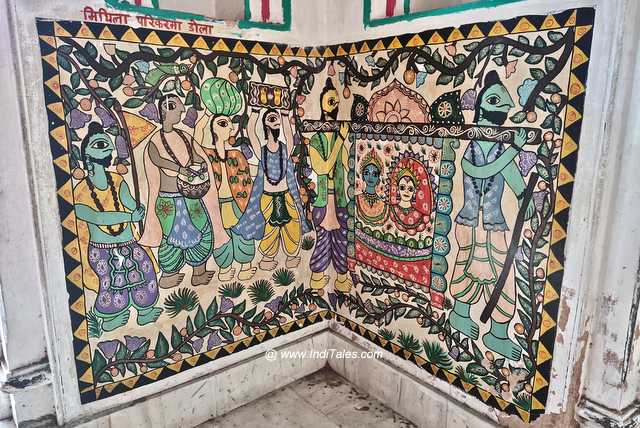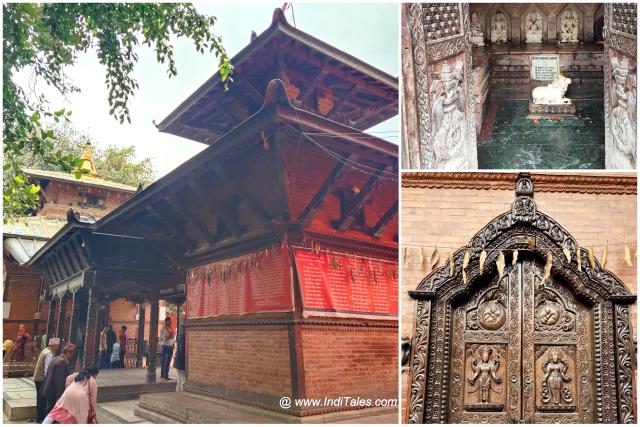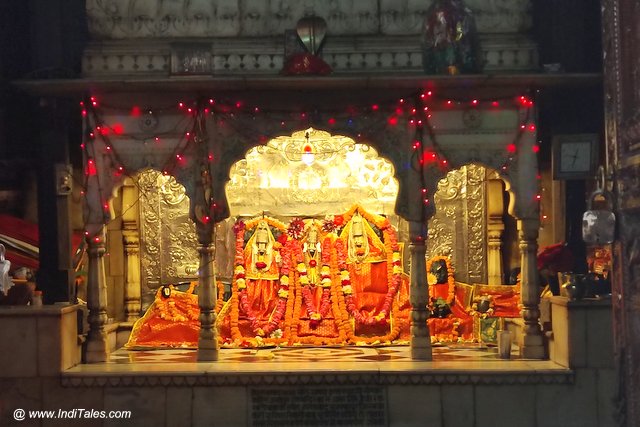Janakpur Dham is the ancient capital of Mithila. Today, it falls within the political boundaries of Nepal, but culturally it remains an integral part of Mithilanchal. This district of Nepal that has Janakpur, is called Dhanush after the Dhanush or bow that was broken here during the Ramayana era.
Ramayana and Janakpur
There are two Yatras or travels that form the core of Ramayana story. Of these the later one where Sri Ram travels southwards and fights with Ravana of Lanka is more famous in the public memory.
The first travel he does is to Janakpur with his Guru Vishwamitra. This is where in a garden he first met Sita Ji. Then, he went on the break the Dhanush of Shiva to win Sita’s hand. He and his three brothers get married to Sita and her three sisters in Janakpur.
Goswami Tulsidas in Ramcharitmanas describe the wedding of Sri Ram and Janaki in great details. Vivah Panchami, the date on which the wedding happened is still celebrated as a festival in Janakpur as well as in Ayodhya.
Story of Ma Sita
Sita was found in the field by Raja Janak of Mithila after he worshipped Haleshwar Mahadev. The place today is identified as Sitamarhi. She was raised in his palace at Janakpur.

When it was time for her marriage, Raja Janak announced that whoever can break the bow or Dhanush of Shiva will win the hand of Sita. A day before the Swayamvara, or choosing of the groom, Sita ji and Sri Ram happened to come across each other in a garden. They do not speak but know that they are meant to be together.
Sita prays to the Gauri or Parvati and silently tells her wish to marry Sri Ram. As destiny would have it, Sri Ram broke the bow and was married to Sita. His brothers Bharat, Lakshman and Shatrughan were respectively married to Sita’s sisters Mandovi, Urmila and Shrutikirti.
The elaborate rituals of a Maithili wedding are a part of the Ramayana story, as is the hospitality of Janak. Women of Mithila take pride in the fact that Sri Ram is their son-in-law and they have the right to tease him. Folk songs of Mithila do celebrate this relationship.
Janakpur Dham
Janakpur Dham was on my wish list since the time I explored Ayodhya and translated Ayodhya Mahatmya. I have been to most places associated with Ramayana, including most of Ramayana sites in Sri Lanka, but Mithila eluded me for a long time.

I had seen visuals of a huge Janaki temple in Janakpur. Now that and equally grand temple is coming up for Janaki in Ayodhya, I think it was time to see her temple in her maiden home.
Temple is huge and immediately reminded me of the Haveli of Srinathiji in Nathdwara. The Rajasthani architecture is evident in the first site. I tried connecting the two, but it was in a conversation with the priest here that I learnt that indeed the temple was built by the saints of Galata Ji temple of Jaipur.
The temple is also called Naulakha Mandir as Rani Vrish Bhanu of Tikamgarh spent close to nine lakh gold coins to build this temple in 1910 CE. It was built at a spot where a golden murti was Ma Sita was discovered in the 17th CE. As per the UNESCO website, the oldest parts of the temple date back to 11-12th CE.
There is ample space with white marble ground outside the main door of the temple. You take off your shoes and walk to the door. The place is full of devotees, including many newly wed couples in their wedding finery.
Inside Janakpur Dham
As you step inside the main door, you see a beautiful temple in the middle of a courtyard. It is surrounded by a running corridor on all sides, pretty much like a Shekhawati Haveli.

The temple in white is painted with bright and vibrant colors. I climbed the steps of the temple and the Ram Darbar was right in front of my eyes in full glory. You see all the four brothers with their four wives from Mithila. The day I visited, it was a golden shringar that added its own light to the aura.
Cultural Museum
A museum telling the story of Sita is housed on the first floor of the temple corridor. It has dioramas to depict the story. I loved the Badhai Geet that are played when you reach the scene of Sita’s birth. Breaking of Dhanush by Sri Ram remains the most celebrated scene here.

There are dresses and jewelery of Sita Ma on display.
Surrounding walls are made of Mithila or Madhubani Paintings. They typically depict the wedding rituals of Ram Janaki wedding. However, Mithila Parikrama Dola was an interesting painting that depicts the parikrama path that goes around Janakpur. There are paintings depicting the daily life of people like ironsmith.

From the museum, you come out on the roof of the temple. From here you get a full panoramic view of the temple in the middle. It is favorite place to click pictures.
Saligrama Mandir
We all know that Saligrama stones come from Gandaki river in Nepal. In fact, the shila or stone for the making of Sri Ram Murti at new temple in Ayodhya was also sent from Janakpur. You can see a similar big Shila in the temple complex.

A room in the temple is dedicated to millions of Saligramas. They are kept in a tiered container that can only be viewed through a mesh. You can see Saligrama stones in pitch black, in all kinds of shapes and sizes.
They are worshipped every day as is evident from the fresh flowers offered to them. Some of them are adorned with jewelry and clothes.
Ram Sita Dhun
Just like the temples of Ayodhya, Ram Dhun is continuously being sung at an open platform next to the Saligrama room.
You can join in and sing the Ram Naam, that is the simplest way to worship, especially in this Kaliyuga.
Ram Janaki Vivah Mandap
Within the temple complex but outside the boundary of main temple, on a side is the Vivah Mandap. This structure with the slanting Nepalese roof is almost an open pavilion. Inside it, you see the scene of royal wedding depicted.

On the four corners of the platform are four small temples dedicated to the four royal couples who got marries here. Bit for the names mentioned on them, you would not be able to make out which one belongs to whom.
Walk around the Janaki Mandap and the temple garden. Stop at the Gau Shala and you can feed the cows if you like.
At one of the platforms, you can see the footprints. This is where the Utsav Murtis are kept when they step out for parikrama.
There is a small Shiva temple with Ekadash linga, i.e. 11 lingas together in pne Shivalinga.
Festivals at Janaki Mandir Janakpur
Vivah Panchami that is celebrated on Margsheesh Shukla Panchmai is the most important festival here. It is obvious as Janakpur was the venue for this wedding.
Ram Navami, the birth of Sri Ram, that falls on Chaitra Shukla Navami is celebrated with great fervour. I visited the temple a few days before Ram Navami and the temple was getting ready to celebrate it.
Dashain or Dussehra is a big festival in Nepal. Read more about it in our book – Navaratri – When Devi Comes Home.
Other Temples in Janakpur
Just like Ayodhya, Janakpur is also full of temples and ponds. There are as amany as 70 ponds in the region. Some of the temples that you can see
Ram Mandir

This small temple located close to Janaki temple and opposite Dhanush Sagar pond. Built by Amar Singh Thapa, extremely beautiful temple is made in typical Nepali architecture. It has wood carved panels that leave you mesmerized.

Surrounding the Ram Mandir there are many Shivalingas. There is Devi present in the form of a Pindi.
When I visited, a group of women were singing Bhajans.
Raj Debi Temple
Located right next to the Ram Mandir, this temple is dedicated to the Kuldevi of Janaka called Raj Debi Temple. It is located in one corner of the large courtyard that has a triangular Yagna kunda. Lions guard the walkway, indicating her to be a Swaroop of Durga.
Janak Mandir
In between Janaki Mandir and Ram Mandir, right in the middle of the road is a temple in bright orange. This is dedicated to the king of Janakpur or Raja Janak. He is called Rajrishi or the Saint King.
Lakshman Mandir
It is located right at the entrance of the Janaki Mandir.
Other temples in Janakpur include Sankat Mochan Temple dedicated to Hanuman ji, Kapileshwar Temple and Bhootnath Mandir.
Ponds of Janakpur

Gangasagar – located close to Vivah Mandap across the road. It is believed that the water for this pond was brought from Ganga.
Ram Sagar
Dhanush Sagar – Located close to Ram Mandir
Ratna Sagar
Dashrath Kund
Kamal Kund
Sita Maiyya Taliayya
Jaleshwar Mahadev Temple – This is an important Shiva temple located about 16 km from Janakpur on way to Sitamarhi.
Dhanush Dham – It is dedicated to the Shiva’s Dhanush or Bow that was broken by Sri Ram. This is about 24 km North East of Janakpur. You would need to stay in Janakpur to be able to visit it.
Parikrama
There is a Panch Kosi Parikrama that goes around the Janakpur Dham. Although you can do this Parikrama any day, regular devotees do it on the day of Holika Dahan.
You can also see the Gangasagar Public library and Handicrafts museum that I had to miss die to paucity of time.
Travel Tips for Janakpur Dham

Janakpur is about 2 hours drive from Darbhanga, which is the closest airport and train station. On the Nepal side, there is an airport at Janakpur that connects to Kathmandu.
Border crossing takes 20-40 minutes depending on the traffic. You can take your personal vehicles or taxis to Janakpur.
Indian currency works in Janakpur.
Food options are limited, though lots of sweets and fruits are available. The temple has a bhandara everyday around lunch time and you are welcome to eat there.
You need about 2-3 hours to comfortably see the things I mentioned.
